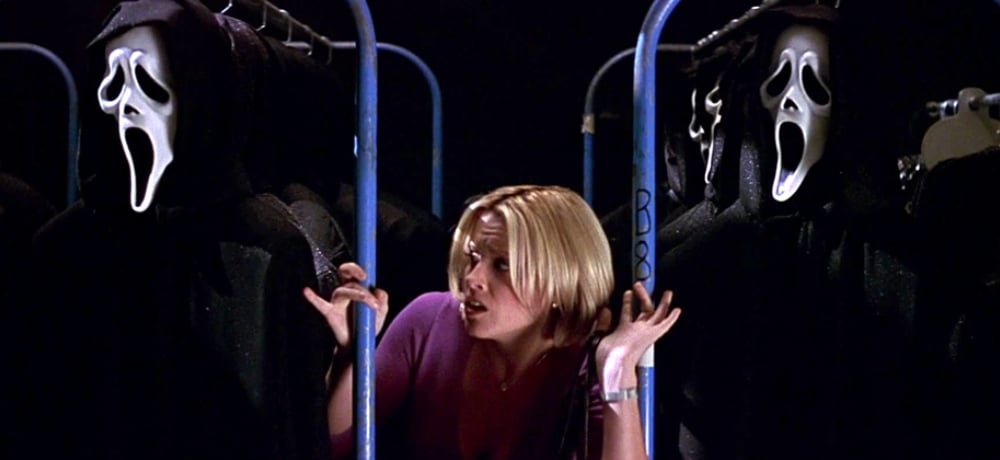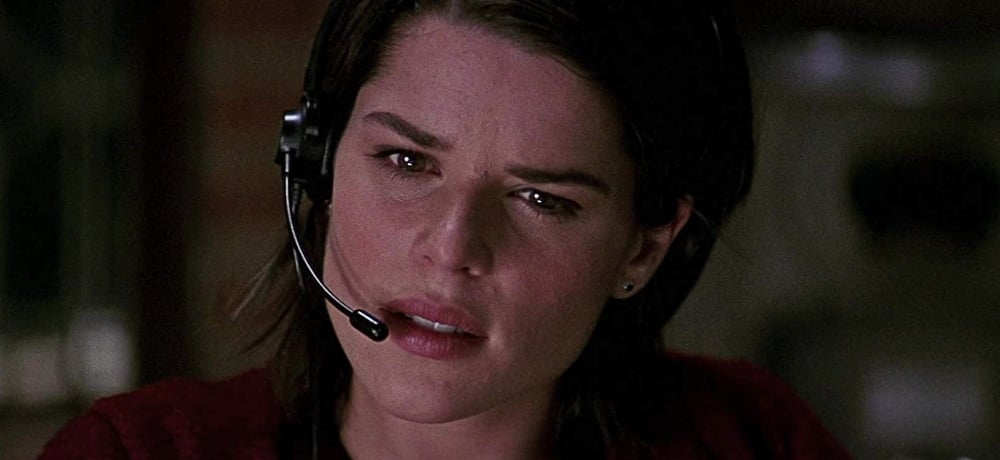


After 20 years, Wes Craven’s Scream 3 currently sits at a 39 percent approval rating on Rotten Tomatoes. And while RT scores are hardly the only way to define a film’s quality status, Scream 3 still remains something of a punching bag for fans of the franchise (we get it—Gale’s bangs are weird! WOW!), and I’m here to say that while it’s not the strongest entry in the series, Scream 3 deserves so much more love than it gets, and after two decades, it’s time more genre fans recognized the greatness that is contained within its 116-minute running time.
It may not have the breakout opening that we get at the start of Scream, or the visceral gut-punch of Scream 2's tone-setting theater killings, but I really love how amped up everything feels during Scream 3’s opener (there are a few other scenes here, like the multiple Ghostface costumes in wardrobe, or the house explosion setup, that are absolutely right up there as peak franchise moments for the Scream series). But we open with Cotton Weary—the underappreciated MVP of Scream 2, Liev Schreiber—in full-blown douchebag mode, donning an all-white suit, lamenting his decision to do a second-rate slasher which he now feels is beneath him as one of the premiere talk show hosts in America. Cotton, who had previously been victimized by the justice system, has evolved since we last saw him, where he has a bit of a swagger to him, and my biggest regret when it comes to Scream 3 is that Cotton never gets to elaborate further on the “Stab games” he likes to play with his girlfriend, Christine (Kelly Rutherford).
And while Cotton may have been a bit misunderstood in Scream 2, his moral compass is definitely pointing in some ambiguous directions here, as he initially begins to flirt with a mysterious woman on his phone, only to realize that it’s really Ghostface on the other line, and that Christine is in grave danger. Cotton sets out to fight LA traffic (something I relate to HARD these days) to try and save his special lady friend, but ultimately ends up sealing his fate when he refuses to divulge any information he might have on Sidney’s (Neve Campbell) whereabouts. Make no mistake—Randy’s death in Scream 2 might still be the most shocking death in the franchise, but I think Cotton’s hit me harder, simply because Craven doesn’t shy away from the brutality of that moment like he did with Randy’s murder in the second film.
Something else I’ve always appreciated about Scream 3 is how Ghostface’s motivations in this sequel once again feel deeply personal when it comes to the series’ heroine. Don’t get me wrong: I love the one-two punch of Billy Loomis’ mom and Mickey in Scream 2, but Scream 3 feels a bit more in line with the story from the original film, especially since we see how the actions and death of Maureen Prescott that were explored in Scream weren’t exactly what we had been led to believe after all (similar to Sidney’s own experiences). And yeah, the way writer Ehren Kruger ties Scream 3’s killer back to the events of the first film are a bit clunky once everything is revealed during the film’s climax, but it’s not nearly enough to derail anything that precedes it by any means.
As someone who is a total sucker for movies about movies, that’s a cinematic itch that Scream 3 scratches for me, and I think that’s another reason why I love the sequel as much as I do. Scream 3 went into production shortly after the horrific Columbine High School massacre, so moving the story from a small town like Woodsboro to Hollywood only made sense as a means of separating the violence here from tight-knit communities. Plus, it provides Scream 3 with a copious amount of fun moments that still make me smile as someone who gleans much pleasure out of movies that pull back the curtain on the filmmaking process and put viewers squarely in the middle of the magic of Hollywood.

Not only do we get an entire secondary cast that serves as a reinterpretation of our beloved Scream stars, featuring Jenny McCarthy, Deon Richmond, Matt Keeslar, a still up-and-coming Emily Mortimer, and the indelible Parker Posey as a pseudo-Gale Weathers, but we also get Lance Henriksen and Roger Corman playing higher-ups at Sunrise Studios to boot, which still makes me geek out after all these years. And you can say whatever you want about Scream 3, but any movie that utilizes Posey’s comedic brilliance the way that this film does deserves some freaking respect. The scenes featuring the two Gales on their fact-finding mission at the studio is absolute perfection, too, especially because it also involves the one and only Carrie Fisher playing something of a doppelgänger herself here, a failed actress named Bianca Burnette who missed out on Star Wars because she didn’t “sleep with the director.” Pure gold.
Also, by moving Scream 3 to Hollywood, it affords us a chance to revisit certain aspects of the first film, especially when Sidney is being chased throughout the recreated version of her house at the studio lot, culminating with Dewey (David Arquette) coming to Sidney’s rescue much like he does in the OG Scream after she’s first attacked in that film’s pulse-pounding scene. It’s a sequence that helps pull back the layers on the trauma that Sidney has lived with for years at this point, and how even though she’s done everything she can to try and move on in her life, like working as a crisis counselor, Sidney’s wounds are still fresh and the uncertainties about just who exactly her mother really was are still hanging over her despite Sidney’s best efforts to move on.
And that’s something else that Scream 3 gets right: how Sidney has dealt with everything that has happened to her throughout the course of the first two movies. Now living as a recluse, Sidney has opted to retreat to an idyllic home in the mountains, living with a canine friend while she tries to utilize her own experiences as a means to help other women who are victims of violence. Years ago, I didn’t love that Sidney as a character felt minimized in Scream 3, but now, I appreciate her storyline here so much more, because I think Sidney’s inclination to withdraw from society after watching various psychos kill her mother, her best friend, her college roommate, her kind-hearted boyfriend, and Randy makes sense. Plus, once the sanctity of her safety net is violated, it causes Sidney to become proactive once again, as she realizes that the only way to deal with her problems is to face them head-on.

One unfortunate aspect to Scream 3 is the timeliness of Maureen Prescott’s backstory, especially since the Scream films were produced by uber-POS Harvey Weinstein. We learn through John Milton (Henriksen) that Maureen had been an aspiring actress in the 1970s, and during her brief time in Hollywood, the system took advantage of her burgeoning talent and naiveté. While it may have felt slightly out of place at the time of Scream 3’s release (only because those stories weren’t being shared as widely back then as they are now), it’s absolutely unfortunate just how much that subplot has rung true for so many talented people in the industry for so many years now. And the fact that Harvey just happened to be a producer on a film with this subplot feels way too horribly on the nose, honestly. If only we had been listening 20 years ago…
Which brings us to the final showdown between Sidney and Scream 3’s Ghostface. I will be the first to admit that I do think the wrong character ended up being the killer in this sequel, as it really should have been Detective Kincaid (Patrick Dempsey), not Stab 3 director Roman Bridger (Scott Foley), who was the lunatic behind everything dating back to the events of the first Scream. Honestly, it feels like making Kincaid the killer would have made much more sense overall (especially with the access he had to private information as a police officer, and his own backstory about growing up around the Hollywood system), but I will say that there’s something rather enjoyable about watching a film director who's a bit of a shrieking man-baby just lose his shit and then get his ass handed to him by Sidney during their brutal, knockdown, drag-out fight to the (almost) death.
Look, I get that Scream 3 is never going to be your favorite Scream movie—as an OG Ghostface diehard fan who actually moved up two of her college finals so that she could get home for the opening night of Scream in 1996, it’s not mine, either. But when it comes to trilogies, not only does Scream 3 get far more right than it gets wrong, I find the film’s final moments, when Sidney is finally ready to leave that metaphorical door to her future wide open without hesitation, to not only be extremely satisfying, but a really wonderful way for that character’s journey to wrap up after going through so much trauma and heartache during these three films. And that, coupled with the engagement of Dewey and Gale (Courteney Cox), makes for a splendid capper for the Scream series as whole (not gonna lie—as a writer, I can’t think of a more lovely way to get proposed to than by finding an engagement ring hiding in a book that I wrote).
Rarely do we get these brief glimpses of true happiness in the horror genre, and I think that’s why I love those final scenes so much—after all these characters have been through in these three movies, they deserve their respective moments of bliss. And as a fan of the Scream franchise, it was all I could have hoped for, and so much more, which is why it still feels like such a fulfilling note to end on, even after 20 years.